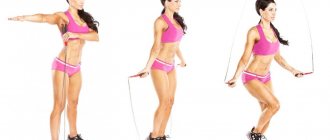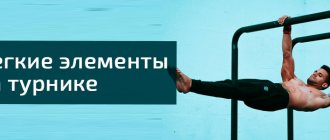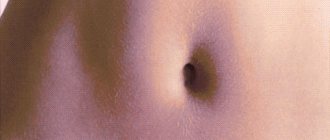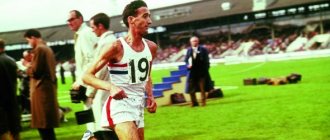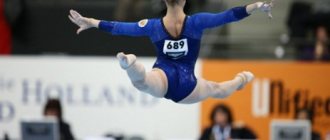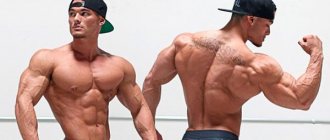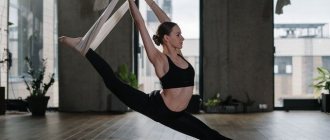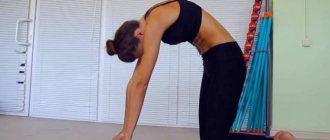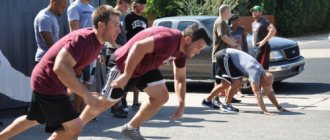- January 28, 2020
- Workouts in the gym
- Maria Klencheva
The wrestler's neck is not made separately from the body. Impressive volumes in this area should be achieved by fully pumping all large muscle groups. This is what the professionals say, and this is how our nature works. A strong neck may be thin, but a “bull” neck is always the result of correct, well-structured training aimed at hypertrophy.
Why shake your neck
The muscles that support the head need to be strengthened regularly. A strong, developed neck copes better with basic functions and ensures normal motor activity when turning and tilting the head. Pumping up this muscle group protects the brain from concussions and the body from sprains and injuries. That is why in many sports, such as martial arts, neck training is done specifically. A wrestling neck is the calling card of a truly strong person!
Even people far from sports will find it useful to perform some of the exercises presented below. And it’s not just that developed neck muscles look beautiful. Regular training serves as an excellent prevention of osteochondrosis, relieves headaches and helps to concentrate.
Why train your neck?
Few modern athletes (with the exception of wrestlers, rugby players and representatives of some martial arts) pay due attention (if at all) to neck training. While there are several good reasons to include a couple of exercises for this muscle group in your training program.
Security and Protection
The neck muscles, along with the trapezius muscles, are a kind of “airbag” for any person. I repeat once again - for any person. While this function of the neck muscles is obvious to boxers, wrestlers and fighters, people who are not involved in daily clinching and grappling may not be clear on why they should spend extra time training the neck. I sincerely hope that you, dear reader, will not have to test this advice in practice. Just realize that well-trained neck and trapezius muscles could one day save your life. Of course, this is not a 100% guarantee of your invulnerability, but still, repeated accidents with athletes whose necks and trapezius prevented fractures of their cervical vertebrae and reduced the degree of concussion give us a chance to think and not regret the 5-10 minutes spent on neck training .
Improved well-being and brain activity
By training the neck, we improve blood circulation in the brain, thereby supplying it with additional oxygen and nutrients. Also, good tone of the neck muscles allows you to improve your posture. Often, being in front of the computer for a long time, slouching and spasming the muscles of the back and neck, we experience headaches, decreased performance and fatigue. It is a good idea, along with regular neck training, to do a light warm-up for the neck, eyes, and whole body while at work.
Increased strength and athletic performance
Well-trained neck muscles provide stability in the thoracic spine, which gives us the ability to lift more in the deadlift, squat, bench press and almost all other exercises.
Aesthetics and the “look of Power”
What makes us, taking a quick look at another athlete, wrestler or rugby player, immediately understand that he is strong? What makes up this elusive and so-desired “look of Power”? It is unlikely that these are large biceps or pectoral muscles... It is easy to verify this by meeting some bodybuilders with impressive development of these muscle groups, but who do not pay the same attention to their trapezius and neck, fearing to visually narrow their shoulders and give them a sloping appearance. Without going into the complex topic of aesthetics in bodybuilding, I will say that there is nothing sadder in the appearance of the “future Mr. Olympia” than a thin neck (except perhaps ignoring the leg muscles). Two areas of your body that are almost always visible and visible are your neck and forearms. Draw your own conclusions. For those who do not want to acquire a “bull neck”, lose proportions and symmetry, as well as lovely ladies, please do not close the article - you can get all the above benefits without a serious increase in neck volume by adjusting the volume and intensity of the exercises performed.
Now let's look at those simple exercises with which we can train our neck.
1) Manual resistance exercises
If you are just starting to train, or don’t train at all, or if you don’t have any other equipment, you should start with exercises for the neck where you use the force of your own hands as resistance.
Perform neck extensions, flexions, and lateral bends using manual resistance. You can also use a towel for convenience.
2) Neck extension with a clamp. Especially for this exercise, they blow a special clamp on which the plates are hung, or rubber bands can be used as resistance.
3) Neck curl with a plate
Take a light weight plate, a small towel, and lie with your back on the bench so that your head hangs down. Place the pancake on your forehead, with a towel between your forehead and the pancake. Now, holding the plate with your hands, bend your neck, trying to touch your chin to your chest.
4) Exercises on the wrestling bridge
I do not recommend them for beginners or those who doubt their technique, as they can easily get injured. After several months of regular training with manual resistance and a clamp, you can begin to master the wrestling bridge stance with your hands on the floor. Then proceed to smooth swaying movements with your head and body, adjusting the load by pressing your hands to the floor.
Start with 1-2 sets of 15-25 repetitions. Very gradually increase the load, weights and repetitions.
Why doesn't my neck grow?
One of the most important reasons is the lack of heavy basic exercises and strength progression in the training program.
Not all athletes and athletes can boast of a wrestler's neck. The increase in muscle volume in this area occurs mainly through performing basic exercises. But the direct “involvement” of muscle work through isolation exercises is clearly overrated in terms of growth.
This means that it will be unrealistic to pump up the “bull neck” by training specifically with your own weight, light weights or little resistance.
It has been noted that heavy strength exercises provide an increase in body weight, including an increase in volume in the cervical spine. Depending on the execution options, the target muscles can participate indirectly, but even then the resulting load will provoke hypertrophy.
Correcting goose neck can be difficult not only for those who neglect basic exercises and train haphazardly. This process can be affected by diet, environment, genetics, and even stress!
Warm-up
The neck muscles are easily injured, and the consequences can be very serious. Warm-up should be done with concentration, without sudden movements. Before training, it is better to do light cardio and then move on to joint warm-up.
All variations of loads for pumping the neck come down to three main movements: flexion, extension and rotation. When warming up, these movements are performed without weights or resistance.
- Tilts of the head forward are performed by flexing the neck muscles and bringing the chin to the chest.
- Tilts of the head back are performed similarly due to extension, while the chin moves in the direction from the chest.
- Tilts of the head to the sides are performed using the lateral muscles of the neck when bringing the ear to the shoulder.
- Turning the head to the sides is performed by bringing the chin to the shoulder.
The optimal warm-up duration is 5 minutes, at a comfortable pace, allowing you to do 10-12 repetitions for each position. In this case, it is most convenient to alternate tilting the head back and forth and to the sides, as well as turning the head left and right.
The best moment of the transition from warm-up to training is the feeling of pleasant warmth in the muscles.
content .. 99 100 101 102WRESTLER EXERCISES TO MASTER THE BRIDGE
1. Standing on the bridge from a lying position
. From a lying position on your back, bend your knees and place them shoulder-width apart. Place your palms on the carpet near your ears. Raising and bending in the lumbar, thoracic and cervical sections of the spinal column, rest your forehead on the carpet (Fig. 458-a, b).
2. Exercises in the bridge position
. Movement of the body forward and backward; when the body moves towards the head, touch the carpet with your nose, and when towards the legs, touch the carpet with the back of your head and shoulder blades.
At first, this exercise is done with emphasis on the hands, and as the neck muscles strengthen, the hands are placed on the chest or on the carpet behind the head. Then, as the body moves, the head is turned to the right and left; the head is also turned when the body moves towards the legs. This exercise is carried out with and without the help of hands (Fig. 459-a, b, c).
3. Standing on the bridge from a standing position
. The wrestler, bending back strongly, lowers himself and stands straight on his forehead. In this case, it is necessary that the head is thrown back strongly and the muscles are tense. It is necessary to begin learning how to stand on a bridge from a standing position with the help of a partner who supports the hand of the person standing on the bridge. The partner can also support the exerciser by the arm and lower back (Fig. 460-a). As this exercise is mastered, the partner provides the wrestler with less and less assistance. Then comes the time when the wrestler stands on the bridge on his own. In this case, at first the exercise is performed with the hands and head resting on the carpet, and later without the help of hands (Fig. 460-b).
4. Running around your head
. From a standing position on the bridge, place your hands behind your head with your forearms on the carpet. Select an object in your field of vision and look at it. Without turning your head, take a few steps in one direction and turn your chest down, continuing to move your legs in the same direction, again stand on the bridge. Thus, changing position, describe a complete circle around the head with your legs (Fig. 461-a, 6, c, d, e, f). When moving from the bridge position to the chest, at the last moment there is a “twisting” of the spinal column: from being bent it becomes bent. When crossing the bridge, a similar movement is performed, but in the opposite direction.
5. Overhead bridge flip
. Grab the edge of the carpet with your hands (partner’s legs, barbell, weights, training bag), bend strongly, transfer the weight of the body more to the head, push off the carpet with your feet, throw your legs and torso over your head and stand in a position with your legs apart with support on your forehead (Fig. 462—a, b, c). In the future, this exercise is performed without a partner (Fig. 463-a, b, c).
6. Flip from the rack over the bridge
. Bend back, bend your knees and lower yourself onto the bridge. At the moment your head touches the carpet, push off with your feet, roll over your head and stand in a position with your legs apart, resting on your forehead, push off with your hands and stand in a standing position. At first, the exercise is performed with support from the hands (Fig. 464-a, b, c, d, e). The fall should occur steeply on the frontal part.
WRESTLER EXERCISES TO STRENGTHEN THE BRIDGE
1. Bend back while kneeling
. Kneel shoulder-width apart, bend at the waist and, strongly tilting your head back, touch the carpet with the top of your forehead. First, the exercise is done with the help of a partner (Fig. 465).
2. Side roll
. From a lying position on your back with arms and legs outstretched, turn onto your stomach, bending so that neither arms nor legs touch the carpet. The exercise is made more difficult by holding medicine balls with your hands and between your feet (Fig. 466 - a, b).
3. Rising from a forward bridge position
. Standing on the bridge, bend strongly, shift the weight of your body forward and stand forward on your feet (Fig. 467).
4. Push-ups on hands from a bridge position on the head
. Stand on the bridge, place both hands at your head, push up to the position of a gymnastic bridge (on your hands) and lower yourself to the starting position (Fig. 468 - a).
5. Alternately lifting legs from a bridge position
. Standing in the bridge position, alternately raise your right and left legs up to the limit (Fig. 468-b). This exercise is especially important for performing techniques in freestyle wrestling.
6. Flexion and extension of the neck while resting on the carpet
. From a standing position, legs apart, lean forward and rest your forehead on the carpet. Perform movements forward, touching the carpet with the back of your head, and backward, touching the carpet with your nose. From the same position, make sideways movements, touching the carpet alternately with one and the other ear. First, the exercise is performed with the hands (Fig. 469-a, b).
Exercises to strengthen the bridge using apparatus.
A training bag (stuffed animal), a barbell (preferably a ball barbell) and weights are used as equipment. While standing on the bridge, put a bag or stuffed animal on yourself, clasp it with your hands and perform exercises on the bridge, as they are described in exercise 2 on page 575 (Fig. 470-a). These exercises can be performed with a barbell (Fig. 470-b), with kettlebells (Fig. 470-c) and with a partner (Fig. 470-d).
In the position on the bridge, perform the following exercises with apparatus: squeeze the barbell to outstretched arms from the chest; squeeze the barbell and weights from behind your head; stand from the stand on the bridge with the stuffed animal (at the moment the head touches the carpet, the stuffed animal remains on the chest).
content .. 99 100 101 102
Get a strong neck without leaving home
Those who are just starting to exercise their neck muscles should pay attention to the volitional gymnastics of Dr. A.K. Anokhin. All exercises are performed solely through one’s own efforts in a state of maximum muscle tension.
To do this, you need to strongly strain your neck muscles in each of the starting positions for 15-25 seconds. The length of time under load always depends on the level of physical fitness of the trainee.
Performing exercises to strengthen the neck muscles is useful for those who do not yet have basic training to perform strength exercises. It is not necessary to have special equipment or go to a fitness club.
Light resistance with your hands significantly increases the effectiveness of neck training when performing normal bends and turns of the head.
- I. p. - sitting, clasp your hands at the back of your head. Using muscle effort to overcome resistance, tilt your head back.
- I. p. - sitting, place your palms on your forehead. Similarly, overcome resistance by tilting your head forward.
- I. p. - sitting, palm resting just above the ear. Tilt your head left and right, overcoming the resistance of your hand.
You can perform these exercises from a standing position and even lying on the floor or on a bench.
The neck exercise with a ball is simple, effective and safe, with which you can start pumping up your muscles. The only drawback of this exercise is the lack of strength progression. That is, the resistance is determined by such parameters as the size, stiffness and elasticity of the ball. But over time, you can increase the number of repetitions.
It is necessary to place the ball close to the wall at forehead level, and using the muscles of the neck, rhythmically, but without jerking, press it into the surface. Do 3-4 working sets of 12-15 repetitions, then change position and perform the same, placing the ball just above the ear on each side, and then on the back of the head.
Pumping up the neck
You should start the main workout only after warming up. The duration of each action increases as the represented muscle group is pumped. At the initial stage, allocate 10-15 minutes a day for pumping, gradually increasing the load. This will avoid injuries and increase the effectiveness of the fighter’s physical training.
Rifles
We place emphasis on our head and arms, spread our legs wider than our shoulders, and stand on our toes. Gradually roll your head back and forth, left and right. Not only the neck muscle group is involved, but also the legs, shoulder girdle, and arms. The whole body works in this way, which significantly improves spatial coordination and overall physical fitness. If this exercise is performed for the first time, distribute most of the load on your arms. As the neck is pumped, the hands begin to participate in the process less, and then are removed behind the back. The number of repetitions is no more than 10-15 times, approaches are 2-3.
Bridge
Take the “bridge” position, touching your head to the floor. We carry out smooth rolls with our heads back and forth. Moving the head left and right is prohibited as this increases the risk of injury. Initially, when performing this exercise, place more emphasis on your arms. As your neck muscles strengthen, you can cross your arms and place them on your chest or stomach. Beginner athletes are recommended to stand on the bridge from their back. The number of repetitions is no more than 10-15 times, approaches are 2-3.
Bortsovsky Bridge
The exercise is recommended for a high level of general physical fitness of the fighter. It’s called the “wrestling bridge” and helps strengthen not only the muscles of the neck, but also the shoulder girdle, legs, and arms. We take a position with emphasis on the head, arms spread to the sides, legs brought together. With a rare movement, we push off the floor with our legs, throw them over our heads, and land them behind our backs. Next, we push off with our feet and land in the starting position. The number of times is individual in each case. Initially, this is no more than 3 times, 2-3 approaches per workout. Further, the number of repetitions and approaches increases.
Tilts
We take the position while lying down so that the stomach and chest are on a flat surface and the neck hangs down. We place our hands behind our heads and tilt our heads back and forth. Please note that only the neck is worked, and not the back muscles. If the load is heavy, you can remove your hands from behind your head. If the load is insufficient, weight can be added using a towel (it is grabbed on both sides and placed behind the head). Maximum weight is achieved with a dumbbell placed behind the head. Initially, 8-10 repetitions of 2-3 approaches are enough with a gradual increase in this number.
Reverse slopes
We take the position while lying down so that the back is on a flat surface and the neck is suspended. You can put your hands behind your head, and then bend forward and back. Again, only the neck works. Weight is applied using a dumbbell. Initially, 10-15 repetitions of 2-3 approaches are provided.
Shrugs
The trapezius muscles are an extension of the neck. During your workout, include at least one exercise for this part of the body. The simplest of them is weighting with dumbbells or kettlebells. We take a standing position, we have the same weight in each hand. Raise your shoulders as high as possible, bringing them towards your neck. In the raised position, the weight is fixed for a few seconds, after which the arms are lowered down. Initially, it is optimal to do 10-15 repetitions in 2-3 sets.
Bull neck workouts in the gym
Here the temptation to abuse the load often arises. There is a lot of different equipment in the gym, which should be used carefully so as not to break your neck. Instead of overloading the target group and trying to achieve a wrestler's neck by hook or by crook, it is better to create a competent training plan that includes basic strength exercises. Separately, you can include exercises for the neck. It would be logical to shake your neck on shoulder and back day.
Classic exercises such as deadlifts, squats, bench presses, and pull-ups help you gain weight. When these exercises are performed correctly, the neck muscles also receive hypertrophy stress.
You can achieve great results with these exercises if you regularly include them in your training program.
- Shrugs with a barbell or dumbbells while standing. This exercise powerfully pumps one of the largest muscles - the trapezius. Powerful upper trapezius and gives the effect of a wrestler's neck. I. p. - standing, barbell or dumbbells lowered down. It is necessary to lift the shoulders up by contracting the trapezius, linger for a few seconds at the top point, and then return to the starting position.
- Bending and extension on a horizontal bench with your own weight, weights or using a head clamp. Pancakes are most often used as weights, which are placed on the forehead, back of the head or temporal area, depending on the exercise. I. p. - lying on a bench, on your back, stomach or side so that your head, neck and shoulders are suspended. For convenience, first put on a hat for practice or wrap the pancake with a towel. Perform flexions, extensions and head tilts using weights. From a sitting position or in a tilted position, flexion or extension of the neck can be conveniently performed using a head clamp.
- Exercises on a special exercise machine for the neck muscles. The obvious advantage of the block simulator is the predetermined amplitude and uniform load - it does not need to be controlled, which means you can fully concentrate on performing the exercise. If there is no special equipment in the gym, any available means (elastic band, expander) will be used.
Practical material on the topic “Exercises for mastering the wrestling bridge”
Exercises for mastering the wrestling bridge
Getting up on the bridge from a lying position. From a lying position on your back, bend your knees and place them shoulder-width apart. Place your palms on the carpet near your ears. Raising yourself and consistently bending in the lumbar, thoracic and cervical sections of the spinal column, rest your forehead on the carpet.
Exercises in the position on the bridge. Movement of the body forward and backward; when the body moves towards the head, touch the carpet with the nose, and when towards the legs, touch the back of the head and shoulder blades.
At first, this exercise is done with emphasis on the hands, and as the neck muscles strengthen, the hands are placed on the chest or on the carpet behind the head. Then, as the body moves, the head is turned to the right and left; the head is also turned when the body moves towards the legs. This exercise is performed with and without the help of hands.
Standing on the bridge from a standing position. The wrestler, bending back strongly, lowers himself and stands straight on his forehead. In this case, it is necessary that the head is thrown back strongly and the muscles are tense. It is necessary to begin learning how to stand on a bridge from a standing position with the help of a partner who supports the hand of the person standing on the bridge. The partner can also support the exerciser by the arm and lower back. As this exercise is mastered, the partner provides the wrestler with less and less assistance. Then comes the time when the wrestler stands on the bridge on his own.
The exercise is performed with the hands and head resting on the carpet, and later – without the help of hands.
Running around your head. From a standing position on the bridge, place your hands behind your head with your forearms on the carpet. Select an object in your field of vision and look at it. Without turning your head, take a few steps in one direction and turn your chest down, continuing to move your legs in the same direction, again stand on the bridge. Thus, changing position, describe a full circle with your legs around your head. When moving from the bridge position to the chest, at the last moment there is a “twisting” of the spinal column: from being bent it becomes bent. When crossing the bridge, a similar movement is performed, but in the opposite direction.
Overhead bridge flip. Grab the edge of the carpet with your hands (partner’s legs, barbell, weights, training bag), bend strongly, transfer the weight of the body to the head, push off the carpet with your feet, throw your legs and torso over your head and stand in a position with legs apart, resting on your forehead.
Flip from the rack over the bridge. Bend back, bend your knees and lower yourself onto the bridge. At the moment your head touches the carpet, push off with your feet, roll over your head and stand in a position with your legs apart, resting on your forehead, push off with your hands and stand in a standing position. At first, the exercise is performed with support from your hands. The fall should occur steeply on the frontal part.
Exercises to strengthen the bridge:
Bend back while kneeling. Kneel shoulder-width apart, bend at the waist and, strongly tilting your head back, touch the carpet with the top of your forehead. First, perform the exercise with the help of a partner, and then independently.
Wrestling exercises
How do wrestlers strengthen their necks, literally a vital area that allows them to last longer in the ring? They have their own methods of pumping this muscle. Special exercises are more dangerous because they are intended to train physically trained people. An example is the famous wrestling neck bridge, which is ideally performed without the use of hands. However, it can also be done in a lightweight version, which is suitable for almost everyone.
It’s worth seeing at least once how wrestlers shake their necks. A neck like a rhinoceros can be achieved using the exercises shown in the video above.
